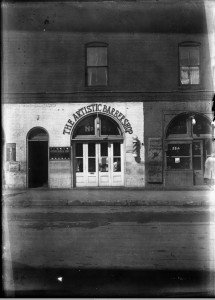My name is Saif Ali. I am a freshman Physics major at Georgia State University, so this is my first year as a SIF (Student Innovation Fellow). I will provide a short auto-biography of myself so that you, the reader, know whose work you are reading. I place my heritage in the country of Bangladesh where my family was born and raised, but I was born here in Atlanta which means I am first-generation American. I graduated from Woodstock High School in the Spring of 2015. At that point, I already knew I was going to GSU, but I was not aware of the SIF program. I became aware of this through the Honors College and immediately knew this is the place I wanted to be. Being exposed to this kind of academic atmosphere is the best way I can start my path to a career in science where research is the main focus of the job.
I am mostly involved in the 3D 1928 Atlanta project. This project involves a team of four researchers and four builders who are re-creating 1928 Atlanta in an Oculus Rift setting. My assignment is researching Peachtree Street, also referred to as Whitehall Street during that time. I have accumulated a significant amount of photos that are from that era, but there are predictable problems that I have run into. I have found pictures that are dated around or on 1928, but I have also found many pictures of Atlanta from the 1930s. I do not feel comfortable putting them aside as useable photos because some of the buildings may not have been built in 1928. The final product must have historical integrity, so even one misplaced building will risk that. All this means is that I must dig deeper and find resources that allow me to gain ground on the pictures that our programmers and builders can use.
These resources cannot stop at the internet though. I can sit at the computer for hours on end searching through the same links, recycling my thoughts and tiring myself with the same images, but that can only take me so far. I would progress with my research much more if I try to find people and places who have resources readily available to me. Perhaps a local historian or a local museum has a pool of pictures that can be used in our project, but all that is useless unless I go out and find them. Although it is cliché to say, networking is extremely important in this kind of work. Doing all the work by yourself is not the most efficient way to complete a project of such magnitude, so I am starting to create a list of potential collaborators that I will contact as soon as possible.
While speaking about the project in our first official 3D Atlanta meeting, the fellows spoke about what details we would eventually like to include in the final product. We spoke about fashion, cars, posters, and annotations that would ice the cake eventually. This immediately reminded me of a story from Neil DeGrasse Tyson about the Visual Design team of the Titanic movie inaccurately portraying the night sky in one of the final scenes.
It would be a shame if we built a gorgeously designed 1928 Atlanta with such rich detail but forget something as important as the sky. Having a hybrid, real-time day and night option through Oculus would be wondrous! To have people put the Oculus goggles on and see what the stars looked like in 1928 Atlanta with the Moon in its correct phase can and will undoubtedly add some panache to the world we create. We can stop at being historically accurate, but why should we? A group like this should strive to build something that no one else can touch, so as much as time and resources allow, there should be no limit to how we build this world.
As I find out more of what I am researching and hear back from those I have contacted, I will update the blog. There is much to look forward to for the rest of the year, and I could not be more excited as to what discoveries will be made.
If there are any questions as to what Oculus Rift is, please see the video below.

